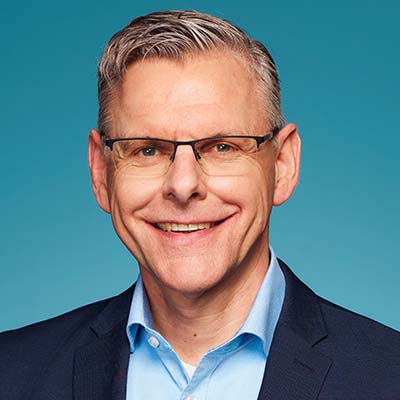

- Dirk Schreiber
- Head of Treasury, BioNTech
Part of BioNTech’s DNA
Innovation and speed have been part of BioNTech’s DNA ever since its formation 16 years ago. Back in 2020, it took the German biotech company less than a year to develop a vaccine against Covid-19. flow’s Desirée Buchholz talked to Dirk Schreiber, BioNTech’s Head of Treasury, on why real-time treasury is key for him – and how APIs help to achieve this goal
When BioNTech was founded in 2008 by Ugur Sahin, Özlem Türeci and Christoph Huber in the German city of Mainz, the three immunologists and oncologists aimed for nothing less than revolutionising the way cancer is treated. “As every cancer type is unique, we believe that immunology and immunotherapy should be able to address each cancer indication in a different way,” states the company’s website.[1]
By January 2020, when the Covid-19 pandemic hit the world, CEO Sahin and his team had already spent more than a decade on the research and development of immunology-based therapies for cancer. BioNTech quickly decided to leverage the work its team had done around messenger RNA (mRNA) to develop a vaccine against Covid-19. This technology instructs cells to produce proteins, resulting in an immune response which helps protect against diseases.
Before the year-end in December 2020, BioNTech and its partner Pfizer – which had joined forces eight months earlier to accelerate the development, distribution and commercialisation of a potential Covid-19 vaccine – received the world’s first authorisation for an mRNA-based vaccine against the previously unknown viral infection without cutting corners.[2] This not only helped to contain the pandemic in certain regions – just as vaccines by Moderna, AstraZeneca and others did – it also marked a scientific turning point by showing the potential of mRNA for vaccine development. While research around this technology dates to the 1970s, it had never been used in an approved treatment before.[3]
Almost overnight, the small German biotech company became known globally – even though its vaccine was sold under the Pfizer brand in several countries. In 2021, BioNTech’s revenue skyrocketed to €18.976bn, up from €482m in 2020.[4]
Following sharply declining demand for its Covid-19 vaccine and its adaptations to virus variants, the company – like every pandemic vaccine player – had to cope with decreasing revenues over the past two years. Still, BioNTech is preparing for future growth again as it plans to launch its first cancer treatment in 2026.[5]
Improving cash investments with real-time treasury
Inevitably, the organisation was initially unprepared for this tremendous growth – as processes and systems were designed for a biotech start-up rather than an international pharma player. When Dirk Schreiber joined BioNTech as Head of Treasury in January 2022, there was no treasury department, but only an accounts payable function, which also managed BioNTech’s payments, Schreiber recalls in his interview with flow: “As we received the first major payment from Pfizer in January 2022, the task was to quickly build a treasury function that was able to handle FX risks associated with US-dollar/euro exchange rate and invest the surplus cash.”
Two-and-a-half years later, he heads a team of six treasury specialists, which has implemented processes around cash pooling, FX management and liquidity investing and completed the roll-out of the SAP S/4HANA Cloud solution for treasury and risk management.[6]
Despite this fast progress Schreiber, whose earlier career includes heading the treasury departments of German automotive supplier Schaeffler and pharma company Fresenius, still sees room for improvement – and for him this is about making the first steps towards implementing a real-time treasury. “I believe that as a treasurer there is enormous benefit in receiving information and transacting in real time – no matter if your company is cash-rich or cash-short,” he says. “As treasury it is essential to optimise your liquidity position, your contribution to the P&L comes via the financial result – and real-time applications allow you to optimise this by speeding up payment flows.”
For BioNTech, its financial performance directly influences investment strategy: By the end of March 2024, the company had a cash balance of €16.9bn[7] which Schreiber and his team had invested in numerous financial instruments including for examples money market funds and government bonds. In the first quarter, the company generated interest income of €175m from this. “A two-day lag in investments can cost a lot of money,” adds Schreiber.
To allocate the income from partners like Pfizer to these financial instruments as quickly and efficiently as possible, Schreiber and his team want to be informed about these incoming payments instantaneously. “As we are moving money between several bank accounts due to hedging and investing requirements, we sometimes have up to five settlements for three-digit million incoming payments,” he explains. “In the past, we had to call the banks to see where the money had got to. Going forward, we want to get this information in real-time via our SAP treasury system.”
Implementing real-time balances
The need for speed explains why BioNTech’s treasury department teamed up in 2023 with SAP and two of its core banking partners – Deutsche Bank and J.P. Morgan. Together, they built a connection via Application Programming Interface (API) though SAP’s Multi-Bank Connectivity (MBC) solution.
In general, this solution provides corporates with a cloud-based channel to exchange all types of payment and cash management messages between their TMS and their banks.[8] Traditionally, this connection was possible via Swift, Host-to-Host or Electronic Banking Internet Communication Standard (Ebics). Now, BioNTech, SAP and the two banks have implemented a fourth channel, i.e. API.
From June 2024, Deutsche Bank provides BioNTech with real-time account balances and push notifications for credits and debits via API (see Figure 1). “This allows us to have real-time data at every point in time via our standard treasury application,” says Schreiber. Going forward, he would like to expand the usage of the API channel to initiate instant payments, validate payee data before sending a payment and to track payment transactions via Swift GPI.
FIG 1: API-BASED COMMUNICATION BETWEEN BIONTECH AND DEUTSCHE BANK

Source: SAP / Deutsche Bank
“Instant payments would be the perfect supplement to real-time account balances”, says Schreiber. “With instant payments we could avoid the early cut-off times of most ACH systems which would allow us to further optimise cash allocation.” If for example, BioNTech receives a payment from a sales partner in the afternoon, it usually cannot invest that same day due to the cut-off times.
Moreover, currently in Europe this problem cannot be solved via instant payments as the threshold is €100,000 for SEPA (single euro payments area) instant payments. Deutsche Bank has responded by offering instant payments between its branches for up to €250m, to help clients avoid the early cut-off times.
“I hope that with the new EU Instant Payment Regulation, we will see a significant increase of this threshold in October 2025,” Schreiber adds. By then, it will require all payment services providers (PSPs) in the eurozone to be able to send and receive instant payments and new features to address the risk of fraud will be implemented. For more details on the regulation read the flow briefing Taking instant payments in Europe to the next level.
Are APIs the future?
Another use case via API technology that Schreiber is considering is the pre-validation of payments9 to ramp up fraud prevention and improve straight-through-processing. In this case, the BioNTech treasury would be able to confirm the existence of their payment’s beneficiary in real-time, ensuring key account details such as IBAN, name and account number match as well as include a sanction screening.
Schreiber enjoys several advantages in his role – given that he had the opportunity to build a new treasury on a green field. While this was challenging, it also avoided the need of having to deal with legacy systems. “It was clear that when we implement a new set-up this should be future-proof and I truly believe that API s will be the future for corporate treasury,” says Schreiber.
“There are so many innovations out there which allow us to manage treasury more efficiently and make better decisions, but they all depend on real-time information exchange – whether it’s the programming of payment flows or improving cashflow forecasting”, he continues.” That’s why APIs are key and that’s why I would also start using the technology even if I had a legacy set-up, although the opportunity is easier to seize when you are in the middle of an implementation project anyway.”
In some distant future, all bank connectivity could be based on API, Schreiber predicts, especially if APIs will be standardised one day – but until this is the case Swift, Host-to-Host and/or Ebics will still be needed for the daily business.
First published in Deutsche Bank’s flow magazine.
Image credit: © BioNTech SE 2023, all rights reserved


